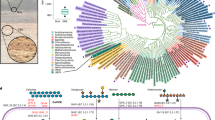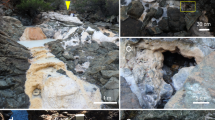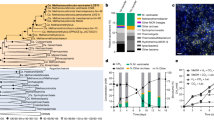Abstract
Cellulose is the most abundant biopolymer on Earth. Optimising energy recovery from this renewable but recalcitrant material is a key issue. The metaproteome expressed by thermophilic communities during cellulose anaerobic digestion was investigated in microcosms. By multiplying the analytical replicates (65 protein fractions analysed by MS/MS) and relying solely on public protein databases, more than 500 non-redundant protein functions were identified. The taxonomic community structure as inferred from the metaproteomic data set was in good overall agreement with 16S rRNA gene tag pyrosequencing and fluorescent in situ hybridisation analyses. Numerous functions related to cellulose and hemicellulose hydrolysis and fermentation catalysed by bacteria related to Caldicellulosiruptor spp. and Clostridium thermocellum were retrieved, indicating their key role in the cellulose-degradation process and also suggesting their complementary action. Despite the abundance of acetate as a major fermentation product, key methanogenesis enzymes from the acetoclastic pathway were not detected. In contrast, enzymes from the hydrogenotrophic pathway affiliated to Methanothermobacter were almost exclusively identified for methanogenesis, suggesting a syntrophic acetate oxidation process coupled to hydrogenotrophic methanogenesis. Isotopic analyses confirmed the high dominance of the hydrogenotrophic methanogenesis. Very surprising was the identification of an abundant proteolytic activity from Coprothermobacter proteolyticus strains, probably acting as scavenger and/or predator performing proteolysis and fermentation. Metaproteomics thus appeared as an efficient tool to unravel and characterise metabolic networks as well as ecological interactions during methanisation bioprocesses. More generally, metaproteomics provides direct functional insights at a limited cost, and its attractiveness should increase in the future as sequence databases are growing exponentially.
Similar content being viewed by others
Log in or create a free account to read this content
Gain free access to this article, as well as selected content from this journal and more on nature.com
or
References
Abram F, Enright AM, O’Reilly J, Botting CH, Collins G, O’Flaherty V . (2011). A metaproteomic approach gives functional insights into anaerobic digestion. J Appl Microbiol 110: 1550–1560.
Bayer EA, Lamed R, White BA, Flint HJ . (2008). From cellulosomes to cellulosomics. Chem Rec 8: 364–377.
Beganovic J, Guillot A, van de Guchte M, Jouan A, Gitton C, Loux V et al (2010). Characterization of the insoluble proteome of Lactococcus lactis by SDS-PAGE LC-MS/MS leads to the identification of new markers of adaptation of the bacteria to the mouse digestive tract. J Proteome Res 9: 677–688.
Bhaya D, Davison M, Barrangou R . (2011). CRISPR-Cas systems in bacteria and archaea: versatile small RNAs for adaptive defense and regulation. Annu Rev Genet 45: 273–297.
Cai H, Gu J, Wang Y . (2011). Protease complement of the thermophilic bacterium Coprothermobacter proteolyticus. In: Arabina HR, Tran Q-N (eds) Proceeding of the International Conference on Bioinformatics and Computational Biology BIOCOMP'11. ISBN: Las Vegas, Nevada, USA, pp 18–21.
Cantarel BL, Coutinho PM, Rancurel C, Bernard T, Lombard V, Henrissat B . (2009). The carbohydrate-active enzymes database (CAZy): an expert resource for glycogenomics. Nucleic Acids Res 37: D233–D238.
Chen Y, Cheng JJ, Creamer KS . (2008). Inhibition of anaerobic digestion process: a review. Biores Technol 99: 4044–4064.
Chouari R, Le Paslier D, Daegelen P, Ginestet P, Weissenbach J, Sghir A . (2005). Novel predominant archaeal and bacterial groups revealed by molecular analysis of an anaerobic sludge digester. Environ Microbiol 7: 1104–1115.
Conrad R . (2005). Quantification of methanogenic pathways using stable carbon isotopic signatures: a review and a proposal. Org Geochem 36: 739–752.
Denef VJ, Shah MB, VerBerkmoes NC, Hettich RL, Banfield JF . (2007). Implications of strain- and species-level sequence divergence for community and isolate shotgun proteomic analysis. J Proteome Res 6: 3152–3161.
Duquesne S, Destoumieux-Garzon D, Peduzzi J, Rebuffat S . (2007). Microcins, gene-encoded antibacterial peptides from enterobacteria. Nat Prod Rep 24: 708–734.
Ellis LD, Holwerda EK, Hogsett D, Rogers S, Shao X, Tschaplinski T et al (2012). Closing the carbon balance for fermentation by Clostridium thermocellum (ATCC 27405). Biores Technol 103: 293–299.
Etchebehere C, Pavan ME, Zorzopulos J, Soubes M, Muxi L . (1998). Coprothermobacter platensis sp. nov., a new anaerobic proteolytic thermophilic bacterium isolated from an anaerobic mesophilic sludge. Int J Syst Bacteriol 48: 1297–1304.
Ganidi N, Tyrrel S, Cartmell E . (2009). Anaerobic digestion foaming causes—a review. Biores Technol 100: 5546–5554.
Gold ND, Martin VJJ . (2007). Global view of the Clostridium thermocellum cellulosome revealed by quantitative proteomic analysis. J Bacteriol 189: 6787–6795.
Hamilton-Brehm SD, Mosher JJ, Vishnivetskaya T, Podar M, Carroll S, Allman S et al (2010). Caldicellulosiruptor obsidiansis sp. nov., an anaerobic, extremely thermophilic, cellulolytic bacterium isolated from Obsidian Pool, Yellowstone National Park. Appl Environ Microbiol 76: 1014–1020.
Hanreich A, Heyer R, Benndorf D, Rapp E, Pioch M, Reichl U et al (2012). Metaproteome analysis to determine the metabolically active part of a thermophilic microbial community producing biogas from agricultural biomass. Can J Microbiol 58: 917–922.
Hattori S . (2008). Syntrophic acetate-oxidizing microbes in methanogenic environments. Microbes Environ 23: 118–127.
Holm-Nielsen JB, Al Seadi T, Oleskowicz-Popiel P . (2009). The future of anaerobic digestion and biogas utilization. Biores Technol 100: 5478–5484.
Imachi H, Sekiguchi Y, Kamagata Y, Hanada S, Ohashi A, Harada H . (2002). Pelotomaculum thermopropionicum gen. nov., sp. nov., an anaerobic, thermophilic, syntrophic propionate-oxidizing bacterium. Int J Syst Evol Microbiol 52: 1729–1735.
Jaenicke S, Ander C, Bekel T, Bisdorf R, Dröge M, Gartemann KH et al (2011). Comparative and joint analysis of two metagenomic datasets from a biogas fermenter obtained by 454-pyrosequencing. PLoS One 6: e14519.
Kersters I, Maestrojuan GM, Torck U, Vancanneyt M, Kersters K, Verstraete W . (1994). Isolation of Coprothermobacter proteolyticus from an anaerobic digest and further characterization of the species. Sys Appl Microbiol 17: 289–295.
Konstantinidis KT, Tiedje JM . (2007). Prokaryotic taxonomy and phylogeny in the genomic era: advancements and challenges ahead. Curr Opin Microbiol 10: 504–509.
Krause L, Diaz NN, Edwards RA, Gartemann K-H, Krömeke H, Neuwger H et al (2008). Taxonomic composition and gene content of a methane producing microbial community isolated from a biogas reactor. J Biotechnol 136: 91–101.
Kröber M, Bekel T, Diaz NN, Goesmann A, Jaenicke S, Krause L et al (2009). Phylogenetic characterization of a biogas plant microbial community integrating clone library 16S-rDNA sequences and metagenome sequence data obtained by 454-pyrosequencing. J Biotechnol 142: 38–49.
Li T, Mazeas L, Sghir A, Leblon G, Bouchez T . (2009). Insights into networks of functional microbes catalysing methanization of cellulose under mesophilic conditions. Environ Microbiol 11: 889–904.
Liu H, Fang HH . (2002). Extraction of extracellular polymeric substances (EPS) of sludges. J Biotechnol 95: 249–256.
Lochner A, Giannone RJ, Keller M, Antranikian G, Graham DE, Hettich RL . (2011). Label-free quantitative proteomics for the extremely thermophilic bacterium Caldicellulosiruptor obsidiansis reveal distinct abundance patterns upon growth on cellobiose, crystalline cellulose, and switchgrass. J Proteome Res 10: 5302–5314.
Maki M, Leung KT, Qin W . (2009). The prospects of cellulase-producing bacteria for the bioconversion of lignocellulosic biomass. Int J Biol Sci 5: 500–516.
Ollivier BM, Mah RA, Ferguson TJ, Boone DR, Garcia JL, Robinson R . (1985). Emendation of the genus Thermobacteroides—Thermobacteroides-Proteolyticus sp-nov, a proteolytic acetogen from a methanogenic enrichment. Int J Syst Bacteriol 35: 425–428.
O’Sullivan C, Burrell PC, Clarke WP, Blackall LL . (2007). A survey of the relative abundance of specific groups of cellulose degrading bacteria in anaerobic environments using fluorescence in situ hybridization. J Appl Microbiol 103: 1332–1343.
Petersen TN, Brunak S, von Heijne G, Nielsen H . (2011). SignalP 4.0: discriminating signal peptides from transmembrane regions. Nat Methods 8: 785–786.
Pierce E, Xie G, Barabote RD, Saunders E, Han CS, Detter JC et al (2008). The complete genome sequence of Moorella thermoacetica (f. Clostridium thermoaceticum). Environ Microbiol 10: 2550–2573.
Plugge CM, Balk M, Zoetendal EG, Stams AJM . (2002). Gelria glutamica gen. nov., sp. nov., a thermophilic, obligately syntrophic, glutamate-degrading anaerobe. Int J Syst Evol Microbiol 52: 401–407.
Qu X, Mazéas L, Vavilin VA, Epissard J, Lemunier M, Mouchel J-M et al (2009). Combined monitoring of changes in delta13CH4 and archaeal community structure during mesophilic methanization of municipal solid waste. FEMS Microbiol Ecol 68: 236–245.
Rademacher A, Zakrzewski M, Schlüter A, Schönberg M, Szczepanowski R, Goesmann A et al (2012). Characterization of microbial biofilms in a thermophilic biogas system by high-throughput metagenome sequencing. FEMS Microbiol Ecol 79: 785–799.
Rawlings ND, Barrett AJ, Bateman A . (2012). MEROPS: the database of proteolytic enzymes, their substrates and inhibitors. Nucleic Acids Res 40: D343–D350.
Riviere D, Desvignes V, Pelletier E, Chaussonnerie S, Guermazi S, Weissenbach J et al (2009). Towards the definition of a core of microorganisms involved in anaerobic digestion of sludge. ISME J 3: 700–714.
Sasaki K, Haruta S, Ueno Y, Ishii M, Igarashi Y . (2007). Microbial population in the biomass adhering to supporting material in a packed-bed reactor degrading organic solid waste. Appl Microbiol Biotechnol 75: 941–952.
Sasaki K, Morita M, Sasaki D, Nagaoka J, Matsumoto N, Ohmura N et al (2011). Syntrophic degradation of proteinaceous materials by the thermophilic strains Coprothermobacter proteolyticus and Methanothermobacter thermautotrophicus. J Biosci Bioeng 112: 469–472.
Schink B . (1997). Energetics of syntrophic cooperation in methanogenic degradation. Microbiol Mol Biol Rev 61: 262–280.
Schlüter A, Bekel T, Diaz NN, Dondrup M, Eichenlaub R, Gartemann KH et al (2008). The metagenome of a biogas-producing microbial community of a production-scale biogas plant fermenter analysed by the 454-pyrosequencing technology. J Biotechnol 136: 77–90.
Schneider T, Riedel K . (2010). Environmental proteomics: analysis of structure and function of microbial communities. Proteomics 10: 785–798.
Sokolova TG, Gonzalez JM, Kostrikina NA, Chernyh NA, Slepova TV, Bonch-Osmolovskaya EA et al (2004). Thermosinus carboxydivorans gen. nov., sp. nov., a new anaerobic, thermophilic, carbon-monoxide-oxidizing, hydrogenogenic bacterium from a hot pool of Yellowstone National Park. Int J Syst Evol Microbiol 54: 2353–2359.
Thauer RK, Kaster A-K, Seedorf H, Buckel W, Hedderich R . (2008). Methanogenic archaea: ecologically relevant differences in energy conservation. Nat Rev Micro 6: 579–591.
van de Werken HJG, Verhaart MRA, VanFossen AL, Willquist K, Lewis DL, Nichols JD et al (2008). Hydrogenomics of the extremely thermophilic bacterium Caldicellulosiruptor saccharolyticus. Appl Environ Microbiol 74: 6720–6729.
van Lier JB, Tilche A, Ahring BK, Macarie H, Moletta R, Dohanyos M et al (2001). New perspectives in anaerobic digestion. Water Sci Technol 43: 1–18.
VanFossen AL, Verhaart MRA, Kengen SMW, Kelly RM . (2009). Carbohydrate utilization patterns for the extremely thermophilic bacterium Caldicellulosiruptor saccharolyticus reveal broad growth substrate preferences. Appl Environ Microbiol 75: 7718–7724.
Ward AJ, Hobbs PJ, Holliman PJ, Jones DL . (2008). Optimisation of the anaerobic digestion of agricultural resources. Biores Technol 99: 7928–7940.
Westerholm M, Dolfing J, Sherry A, Gray ND, Head IM, Schnürer A . (2011). Quantification of syntrophic acetate-oxidising microbial communities in biogas processes. Environ Microbiol Rep 3: 500–505.
Wilmes P, Bond PL . (2004). The application of two-dimensional polyacrylamide gel electrophoresis and downstream analyses to a mixed community of prokaryotic microorganisms. Environ Microbiol 6: 911–920.
Wilmes P, Bond PL . (2009). Microbial community proteomics: elucidating the catalysts and metabolic mechanisms that drive the Earth's biogeochemical cycles. Curr Opin Microbiol 12: 310–317.
Wu M, Ren Q, Durkin AS, Daugherty SC, Brinkac LM, Dodson RJ et al (2005). Life in hot carbon monoxide: the complete genome sequence of Carboxydothermus hydrogenoformans Z-2901. PLoS Genet 1: e65.
Yang SJ, Kataeva I, Hamilton-Brehm SD, Engle NL, Tschaplinski TJ, Doeppke C et al (2009). Efficient degradation of lignocellulosic plant biomass, without pretreatment, by the thermophilic anaerobe ‘Anaerocellum thermophilum’ DSM 6725. Appl Environ Microbiol 75: 4762–4769.
Zakrzewski M, Goesmann A, Jaenicke S, Jünemann S, Eikmeyer F, Szczepanowski R et al (2012). Profiling of the metabolically active community from a production-scale biogas plant by means of high-throughput metatranscriptome sequencing. J Biotechnol 158: 248–258.
Zaneveld JR, Lozupone C, Gordon JI, Knight R . (2010). Ribosomal RNA diversity predicts genome diversity in gut bacteria and their relatives. Nucleic Acids Res 38: 3869–3879.
Acknowledgements
Equipment at Irstea HBAN was acquired in the framework of the LABE project funded by CPER 2007–2013. The project was funded by Agence Nationale de la Recherche, project ANR Bioénergies/DANAC and by the project NSFC (21177096, 50878166). We acknowledge Elie Desmond for his valuable help and discussions on the taxonomic analyses and Yohan Rodolphe for his contribution to the sequencing experiments. The authors also would like to thank the anonymous reviewers for their helpful comments.
Author information
Authors and Affiliations
Corresponding author
Ethics declarations
Competing interests
The authors declare no conflict of interest.
Additional information
Supplementary Information accompanies this paper on the ISME Journal website
Supplementary information
Rights and permissions
About this article
Cite this article
Lü, F., Bize, A., Guillot, A. et al. Metaproteomics of cellulose methanisation under thermophilic conditions reveals a surprisingly high proteolytic activity. ISME J 8, 88–102 (2014). https://doi.org/10.1038/ismej.2013.120
Received:
Revised:
Accepted:
Published:
Issue date:
DOI: https://doi.org/10.1038/ismej.2013.120
Keywords
This article is cited by
-
Methane recovery from acidic tofu wastewater using an anaerobic fixed-bed reactor with bamboo as the biofilm carrier
Journal of Material Cycles and Waste Management (2021)
-
The Relationship Between the Gut Microbiome and Neurodegenerative Diseases
Neuroscience Bulletin (2021)
-
Soil metaproteomics as a tool for monitoring functional microbial communities: promises and challenges
Reviews in Environmental Science and Bio/Technology (2020)
-
Metaproteome analysis reveals that syntrophy, competition, and phage-host interaction shape microbial communities in biogas plants
Microbiome (2019)
-
From proteins to polysaccharides: lifestyle and genetic evolution of Coprothermobacter proteolyticus
The ISME Journal (2019)



